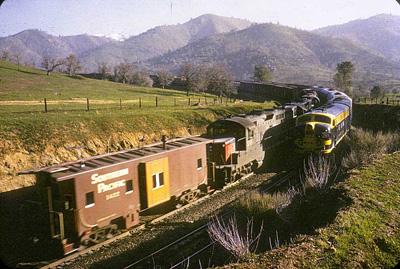The Southern California Railway
"From the Mountains to the Desert to the Sea."
Background | Concept | Construction | Wiring-Control | Signaling & CTC | Operations | Gallery

Santa Ana switcher on the Venta Spur 1969. Photo by Cliff Prather.
Background
Growing up in rural Orange County in Southern California in the late 1950s and early 1960s, railroading for me was first defined by Santa Fe's shiny red and silver PA's in San Diegan service. I worked on a citrus ranch on weekends and during the summer. All around us were vast orange groves divided by stately windbreaks of eucalyptus trees. Santa Fe played a prominent part in the citrus industry and I observed locals and seasonal turns working the sheds spotting and pulling the colorful reefers.

No. 4, Golden State, at Indio 1957. Photo by Gordon Glattenberg.
I lived a short bike ride from Santa Fe's Surf Line and in time, my friends and I discovered that a 32¢ coach ticket on the San Diegan would land us on the platform of the Fullerton depot where we began to experience the rush of Santa Fe's transcontinental traffic. Trains like the Grand Canyon and the Fast Mail Express blistered the rails along with a host of freight trains with such exotic names as the QCX, the SWG, the Hobart Bulldog and the Wilmington Turn.

CTC meet at Walong, 1964. Photo by W. H. Schmid.
Los Angeles Union Depot was just a 90¢ coach ticket away and before long, by taking the passenger trains of the SP, UP and Santa Fe, we had discovered such legendary places as the Summit of Cajon Pass, Tehachapi Pass, SP's Coast Line, Indio, Colton Tower and the complex yards and shops of all three roads in the Los Angeles basin.

Orange groves in Santa Ana Canyon near Esperanza, 1970. Photo by John Signor.
Stan Kistler once referred to this period as "the void." Steam had passed from the scene a few years previously, and along with it many of the railfans had put away their cameras. But the railroads we experienced were vibrant, exciting and still had all the trappings of the steam age - train order offices, complex yards and shops, water tanks, railway mail service and, of course, passenger trains - trains like the Owl, the City of St. Louis, the Chief, the Coast Mail, the San Joaquin Daylight, the Sunset Limited and the Fast Mail Express. Some, like 5 and 6, and 39 and 40, were just identified by numbers. We rode them all.

San Diegan near Gallivan, 1964. Photo by Gordon Glattenberg.
I had started out modeling in 1956 with Lionel equipment, but by 1961, I was introduced to HO scale while earning my Boy Scout merit badge on model railroading.

Union Pacific UTX at I Street in Colton 1964. Photo by W. H. Schmid.
Seasons changed. I went to college, got married, began raising a family and eventually went to work for Southern Pacific booming all over the system from California to Texas. When it came to modeling, however, those vibrant memories of Southern California during "the Void" became the recurring basis of many layouts, from dioramas, to bed room size operations to basement-size pikes. The Southern California Railway is the latest attempt to capture the essence of that special time, now so far in the past, yet so vividly remembered.

Indio in 1960. Photo by Tom Gildersleeve.
In 1991, my family and I moved into a new home. I was able to reserve about 850 square feet over the living room and garage. At last, after years of "making do," I had the opportunity to plan a railroad from the ground up in a space expressly prepared for it.

E local crossing Santa Fe Ave. in Arcadia, 1961. Photo by Bob Melbo.
Home | Consultant | Books | Model Railroad
JohnSignor.com © 2025 John R. Signor. Written or verbal permission is required to reproduce any material contained in this website.
Website by Silver Rockets.